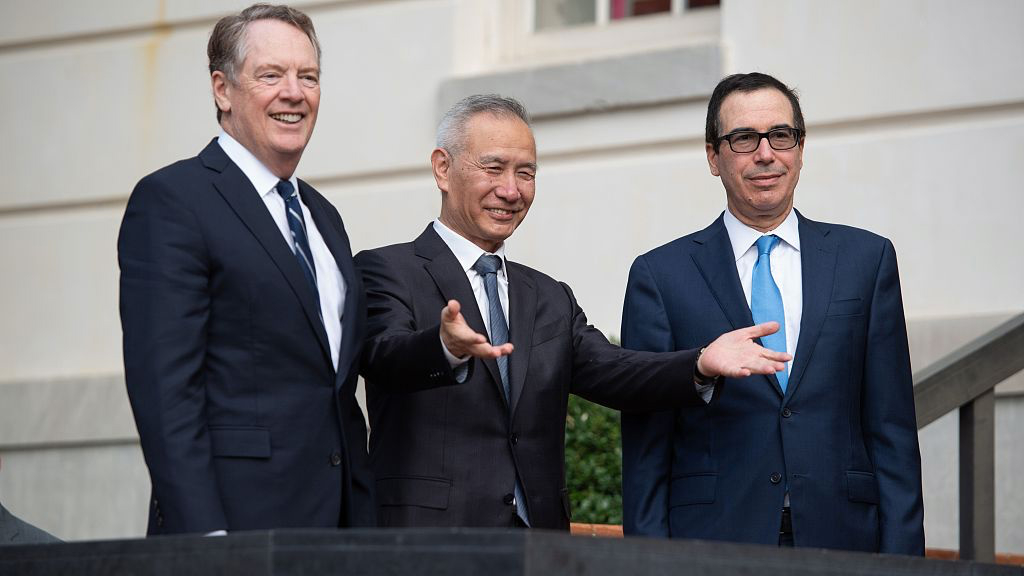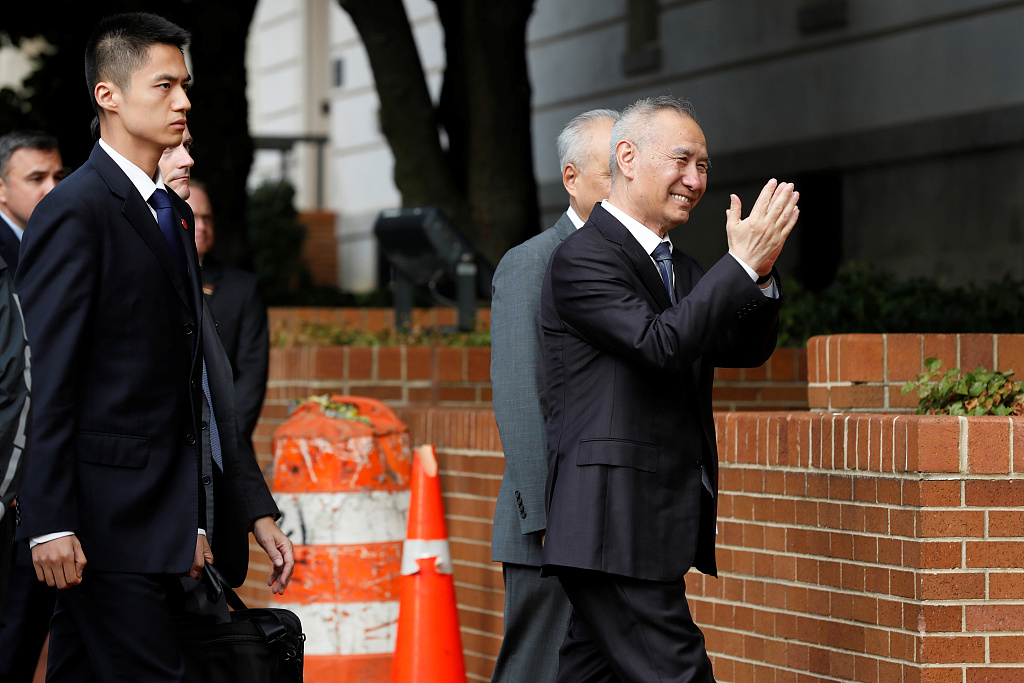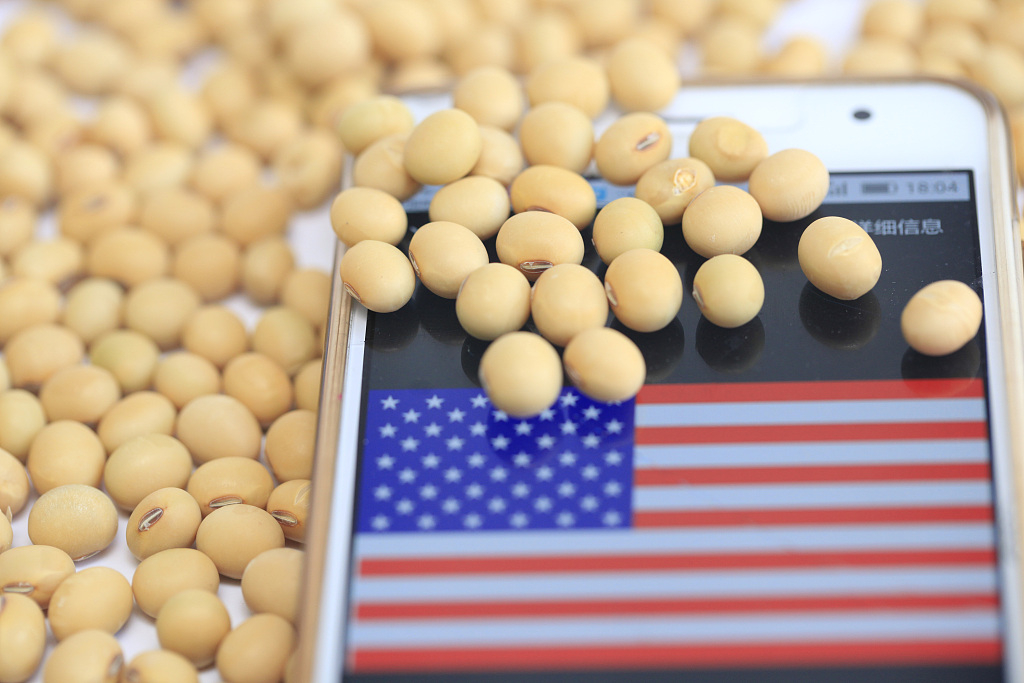
U.S. Treasury Secretary Steven Mnuchin (R) and U.S. Trade Representative Robert Lighthizer (L) greet Chinese Vice Premier Liu He (C) as he arrives for trade talks at the Office of the U.S. Trade Representative in Washington, DC, October 10, 2019. /VCG Photo
U.S. Treasury Secretary Steven Mnuchin (R) and U.S. Trade Representative Robert Lighthizer (L) greet Chinese Vice Premier Liu He (C) as he arrives for trade talks at the Office of the U.S. Trade Representative in Washington, DC, October 10, 2019. /VCG Photo
Editor's note: Zhao Yuanzhen is an opinion editor with CGTN Digital. The article reflects the author's opinion, and not necessarily the views of CGTN.
Faced with an inching deadline on October 15 when another tariff hike kicks in, top negotiators from China and the U.S. are working closely in Washington in search of a partial truce.
The trade consultations did not come at the best time: Just recently, the Trump administration blacklisted 28 Chinese companies over its one-sided accusation of China's Xinjiang policy. For the same reason, it has also imposed visa restrictions on Chinese officials, which Beijing retaliated with stricter visa restrictions for U.S. visitors with anti-China links.
But on the afternoon of the first day, President Trump made an optimistic note, stating that the talks "went very well." He is also expected to meet Liu He, Chinese vice premier and chief of the Chinese delegation. Liu also told the media that the Chinese team has come with "great sincerity" and are willing to address common concerns with the U.S.

China's vice premier Liu He arrives for U.S.-China trade negotiations in Washington, U.S., October 10, 2019. /VCG Photo
China's vice premier Liu He arrives for U.S.-China trade negotiations in Washington, U.S., October 10, 2019. /VCG Photo
So can we expect a deal this time? Not likely, but the progress should be recognized and give some relief to world investors.
"Pursing a partial deal or 'mini deal' means that the two sides have returned to rationality rather than are being driven by emotional sentiments," commented Liu Baocheng, director of the Center for International Business Ethics at the University of International Business and Economics. "They have realized that they have to return to the path of reality and it is the only sensible path."
Liu pointed out that it has already been recognized that trade issues between the two countries are structural issues, including trade balance, market access, and intellectual property protection. But for both sides to draw up a detailed plan on structural economic change in such a short period is impossible. "China's 40 years of reform has been a process of 'trial and error,' so even China itself cannot be 100 percent sure about the details of future reform."
In this scenario, to avoid further damage to both countries' economy, addressing "non-core" and less controversial issues are a realistic choice. China has already started to ramp up purchase of American agricultural goods including soybeans and pork before the talks, with a record weekly volume of pork sales. Liu added that more purchase in energy should also be expected during the talks to reduce U.S.'s trade deficit.

It is also expected that an agreement on currency could be reached during the two-day talks, which intends to prevent China from further devaluing its currency. In August, the exchange rate between Chinese yuan and U.S. dollars surpassed the key psychological level of 7. The Trump administration quickly responded by listing China as a "currency manipulator."
Trump has always lashed out against China over its currency policy, accusing it of devaluing the yuan to gain an unfair advantage in international trade. If the Chinese yuan keeps the current momentum of devaluation, America fears that other countries may also devalue its currency to promote exports. In the meantime, as a responsible major country, China would not devalue its currency casually. China may gain some short-term advantage from currency devaluation, but in the long run, only a stable currency can ensure domestic business and economic development. Thus both sides have the motivation to reach a consensus on currency issues quickly.
"The key is to shake off the feeling of hostility and find the common ground which is conducive to both countries' economic development. America wants China to do more on IP protection, which also happens to be the requirement of China's further reform to become a high-quality economy; making more purchase on soybeans and pork will also benefit Trump voters," said Liu.
So will all these be enough for Trump to cancel the tariffs hikes on October 15 and December 15? Not likely according to Liu. But there might be a decrease in the tariff rate, which has been demanded by the Chinese side. And the U.S. has no reason to refuse it.
It should also be noted that on the previous 12 talks, topics and negotiation agenda were controlled by the U.S. At the latest round of talks, China has actively sought to take a more active role in deciding the topics, which is a gratifying development for China. "The recent close engagement between the two sides have proved that the decoupling danger is a bit far-fetched as the two sides cooled their heads,"concluded Liu.
(If you want to contribute and have specific expertise, please contact us at opinions@cgtn.com.)